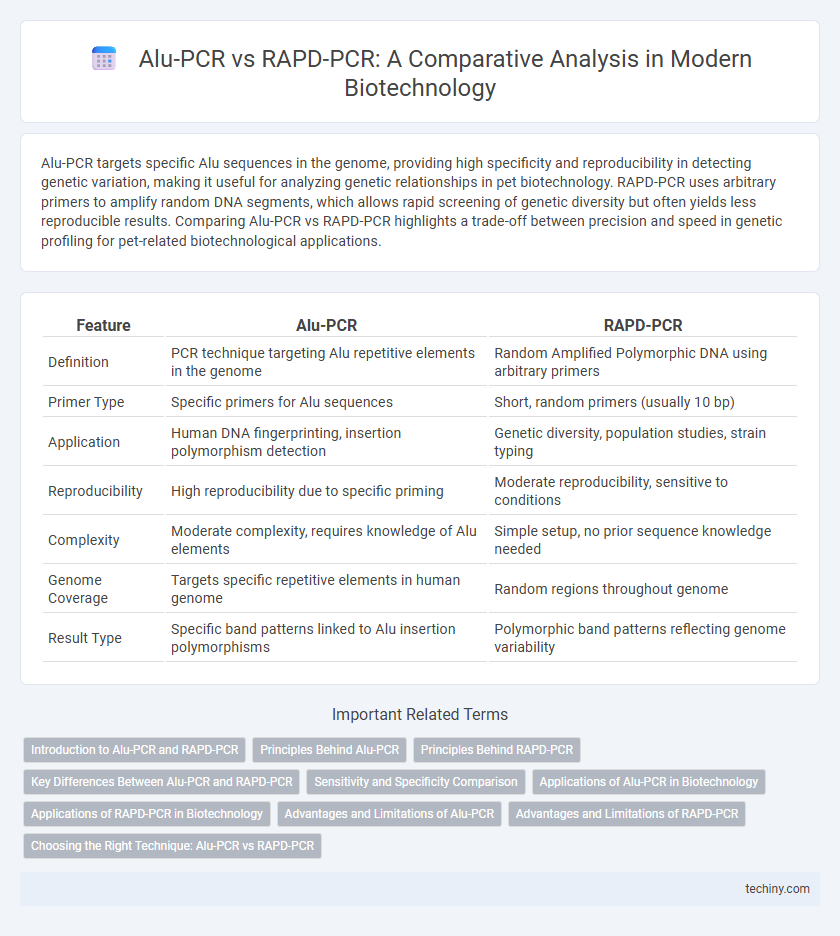Alu-PCR targets specific Alu sequences in the genome, providing high specificity and reproducibility in detecting genetic variation, making it useful for analyzing genetic relationships in pet biotechnology. RAPD-PCR uses arbitrary primers to amplify random DNA segments, which allows rapid screening of genetic diversity but often yields less reproducible results. Comparing Alu-PCR vs RAPD-PCR highlights a trade-off between precision and speed in genetic profiling for pet-related biotechnological applications.
Table of Comparison
| Feature | Alu-PCR | RAPD-PCR |
|---|---|---|
| Definition | PCR technique targeting Alu repetitive elements in the genome | Random Amplified Polymorphic DNA using arbitrary primers |
| Primer Type | Specific primers for Alu sequences | Short, random primers (usually 10 bp) |
| Application | Human DNA fingerprinting, insertion polymorphism detection | Genetic diversity, population studies, strain typing |
| Reproducibility | High reproducibility due to specific priming | Moderate reproducibility, sensitive to conditions |
| Complexity | Moderate complexity, requires knowledge of Alu elements | Simple setup, no prior sequence knowledge needed |
| Genome Coverage | Targets specific repetitive elements in human genome | Random regions throughout genome |
| Result Type | Specific band patterns linked to Alu insertion polymorphisms | Polymorphic band patterns reflecting genome variability |
Introduction to Alu-PCR and RAPD-PCR
Alu-PCR targets the Alu repetitive elements distributed throughout the human genome, enabling the detection of genetic variations and polymorphisms with high specificity. RAPD-PCR utilizes short, arbitrary primers to amplify random DNA segments, facilitating the analysis of genetic diversity and fingerprinting without prior sequence knowledge. Both techniques serve as powerful tools in molecular genetics, offering distinct approaches for genomic profiling and mutation detection.
Principles Behind Alu-PCR
Alu-PCR utilizes short, repetitive Alu elements found abundantly in the human genome as primers to amplify specific DNA regions, enabling precise detection of genetic variations and insertions. This technique leverages the unique distribution of Alu sequences, making it highly effective for studying genomic polymorphisms and evolutionary relationships. Unlike RAPD-PCR, which uses arbitrary primers for random DNA amplification, Alu-PCR targets conserved repetitive elements to produce reproducible and specific amplification patterns.
Principles Behind RAPD-PCR
RAPD-PCR (Random Amplified Polymorphic DNA) relies on the amplification of random DNA segments using short, arbitrary primers under low-stringency conditions, enabling the detection of polymorphisms without prior knowledge of the genome. This technique exploits variations in primer binding sites across different genomes to generate unique DNA fingerprint patterns. The method's principle centers on random priming, which amplifies multiple loci simultaneously, providing rapid and cost-effective genetic profiling compared to Alu-PCR, which targets specific repetitive elements.
Key Differences Between Alu-PCR and RAPD-PCR
Alu-PCR targets specific Alu repetitive elements dispersed throughout the human genome, providing high specificity for human DNA analysis, whereas RAPD-PCR uses random primers to amplify unknown DNA segments, resulting in a broader genetic fingerprint useful across different species. Alu-PCR requires prior knowledge of the Alu sequence for primer design, enhancing reproducibility, while RAPD-PCR's arbitrary primers often lead to variable amplification patterns with lower reproducibility. The sensitivity of Alu-PCR enables detection of low copy number sequences and insertion polymorphisms, contrasting with RAPD-PCR's utility in genetic diversity studies and population genetics due to its capacity to generate multiple random DNA fragments.
Sensitivity and Specificity Comparison
Alu-PCR demonstrates higher sensitivity and specificity compared to RAPD-PCR due to its targeted amplification of Alu repetitive elements, reducing non-specific binding and background noise. RAPD-PCR often produces variable banding patterns with lower reproducibility, limiting its effectiveness in detecting subtle genetic variations. Sensitivity metrics show Alu-PCR detecting low-abundance targets more consistently, making it preferable for clinical and forensic biotechnology applications.
Applications of Alu-PCR in Biotechnology
Alu-PCR is widely used in genetic research for detecting genomic rearrangements and analyzing human genetic diversity due to its ability to target Alu repetitive elements scattered throughout the genome. This technique facilitates the identification of mutations, polymorphisms, and disease-associated genetic variations, making it crucial in cancer genomics and population genetics studies. In contrast to RAPD-PCR, Alu-PCR offers higher specificity and reproducibility, enhancing its application in diagnostics and forensic biotechnology.
Applications of RAPD-PCR in Biotechnology
RAPD-PCR is widely applied in biotechnology for genetic diversity analysis, cultivar identification, and marker-assisted selection due to its ability to generate rapid and reproducible DNA fingerprints without prior sequence information. Unlike Alu-PCR, which targets specific repetitive elements, RAPD-PCR enables the detection of polymorphisms across entire genomes, facilitating plant and microbial breeding programs and environmental biodiversity assessments. Its cost-effectiveness and simplicity make RAPD-PCR a versatile tool for genetic mapping, population genetics, and conservation biology studies.
Advantages and Limitations of Alu-PCR
Alu-PCR offers high specificity by targeting Alu repetitive elements, enabling precise detection of genetic variations and insertions in the human genome. This method has advantages such as reproducibility and the ability to generate unique DNA fingerprints for individual identification, which is valuable in population genetics and forensic studies. Limitations include dependence on the presence and distribution of Alu elements, restricting its applicability to species with abundant Alu sequences, and potential difficulties in interpreting complex banding patterns.
Advantages and Limitations of RAPD-PCR
RAPD-PCR offers rapid, cost-effective DNA fingerprinting without requiring prior genomic sequence information, making it suitable for genetic diversity studies and species identification in biotechnology. However, its limitations include low reproducibility due to sensitivity to reaction conditions and primer-template mismatches, leading to inconsistent amplification profiles. These drawbacks restrict RAPD-PCR's reliability for precise genetic mapping or diagnostic applications compared to more robust techniques like Alu-PCR.
Choosing the Right Technique: Alu-PCR vs RAPD-PCR
Alu-PCR offers high specificity by targeting Alu repetitive elements in the genome, making it ideal for detecting genetic variations and polymorphisms with precision. RAPD-PCR provides a rapid and cost-effective approach for genetic fingerprinting without prior sequence information but may suffer from reproducibility issues. Selecting between Alu-PCR and RAPD-PCR depends on the study's goal, with Alu-PCR suited for detailed genetic analysis and RAPD-PCR favored for preliminary screening and diversity assessment.
Alu-PCR vs RAPD-PCR Infographic

 techiny.com
techiny.com